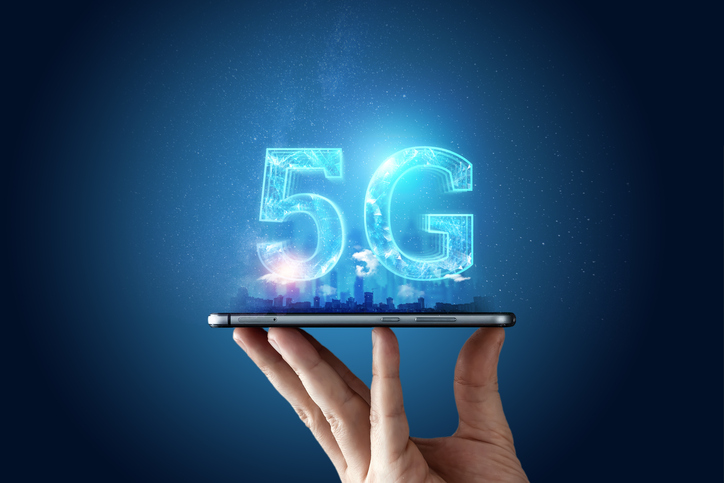5G and edge computing: revolutionizing the retail shopping experience

The adoption of 5G technologies and edge computing presents retailers with an opportunity to overcome technological challenges that will allow them to run more efficient operations and to deliver enhanced shopping experiences. These technologies were highlighted at the Mobile World Congress in Barcelona and are expected to revolutionize the retail shopping experience in the future.
What is 5G?
5G is the fifth generation of cellular networks. Up to 100 times faster than 4G, 5G is creating never-before-seen opportunities for people and businesses. After its introduction in 2019, 5G entered its second wave at the end of 2022, after surpassing the one billion connection mark. A figure that is expected to reach two billion connections by 2025 and more than 5 billion by 2030, according to data from GSMA Intelligence. In January 2023, there were 229 commercial 5G networks worldwide and more than 700 5G smartphone models available to users. This second wave marks the leap to a massive degree of adoption, in more countries and to enable more use cases.
What about edge computing?
Edge computing (sometimes also referred to as Mobile Edge Computing or MEC) is the ability to process data at the edge. That is, at a point much closer to the user and the point from which the information is generated. In contrast, we are talking about cloud computing, a scenario in which data processing takes place on cloud servers.
Why will 5G and edge computing be so important in the future retail shopping experience?
The integration of 5G and edge computing will play a pivotal role in shaping the future of the retail shopping experience. By working together, they offer unrivaled speed and efficiency. The advanced 5G and its future generations, such as 5G-Advanced (planned for 2025), will provide over 100Mb/s bandwidth with less than 1ms latency, outpacing the current 4G network’s average latency of about 50 milliseconds. Additionally, edge computing facilitates faster processing times since it doesn’t require sending as much data to the cloud, as it can be processed close to the source of the data. This feature is crucial for managing a massive amount of data that requires minimal latency to process. For example, in immersive environments like virtual reality applications or the metaverse.
Achieving the full potential of edge computing depends on its relationship with other technologies such as 5G itself, Big Data, or Machine Learning, although it is undoubtedly the type of connectivity offered by 5G that is the main enabler. Without the low latency offered by 5G, edge computing simply does not work properly.
Edge computing also ensures sustainability benefits, as the increased local processing capacity reduces the need for dispatches to the cloud, and with that, energy consumption.
The interoperability challenge for 5G: the Open RAN
The massive implementation of 5G technology necessitates further advancements to tackle the existing challenges. One of the critical obstacles is signal attenuation, particularly for the higher frequency band, which requires the development of better antennas. Moreover, antennas must be adaptable to accommodate a wide variety of devices and increasingly smaller sizes, considering the progress of the Internet of Things (IoT).
But if we talk about the challenges of 5G, interoperability takes center stage. To overcome it, in recent years, a joint effort driven by mobile operators, suppliers, and academic and research institutions has been developed to establish new communication standards that permit various manufacturers to provide hardware and software to unbundled 5G networks.
Thus was born the Open RAN, an infrastructure of open interfaces in the radio access network (RAN), which is being developed within the scope of the O-RAN Alliance, an organization founded in 2018 by AT&T, China Mobile, Deutsche Telekom, NTT DOCOMO, and Orange. Radio Access Networks (RANs) serve to connect base stations that transmit and receive traffic from terminals, such as cell phones and laptops, and provide the link to the operator’s core network. The goal of the Open RAN is to enhance them to be more intelligent, open, virtualized, and fully interoperable so that operators can choose the best equipment from various vendors and combine them to create a customized network that meets their specific needs.
The importance of an Open RAN ecosystem in Europe was demonstrated in a combined report published in 2022 by Deutsche Telekom, Orange, Telecom Italia (TIM), Telefónica, and Vodafone, urging institutions to build it to continue to play a leading role in 5G and, in the future, 6G. Telefónica has already announced a 2023 agreement with NEC to launch pre-commercial trials of the Open RAN network in the Spanish operator’s four main markets: Spain, Germany, the UK, and Brazil. Deutsche Telekom has also announced its first commercial deployment of Open RAN in 2023.
5G is CAPEX intensive, requiring a larger number of cells to achieve the required performance and coverage targets. While it provides many benefits, in terms of the number of devices that can be connected within a given area, for example, it is likely to generate a significant increase in CAPEX. Open RAN can help by controlling this CAPEX, enabling a broader vendor ecosystem and potential cost savings for operators. According to Analysys Mason, one of the world’s leading telecommunications, media, and technology consultancies, Open RAN could generate up to 30% savings in total cost of ownership for operators.
What if we could predict the shopping experience?
With the combination of Open RAN, 5G transmission speeds, and cutting-edge technologies like Artificial Intelligence (AI) and Machine Learning (ML), we can expect new and improved methods to control and maintain network quality. This is crucial for ensuring the high-quality, immersive extended reality experiences that users have come to expect.
Predictive AI and ML models use algorithms to process data by analyzing past and current events and identifying patterns. The implementation of these tools and automation within Open RAN architectures will enable the prediction of future network performance issues and thus their potential impact on the shopping experience, allowing dynamic action to be taken on network elements if necessary. We will go from measuring the shopping experience to predicting it. A fundamental change that will ensure a higher quality shopping experience while making better use of network resources.



